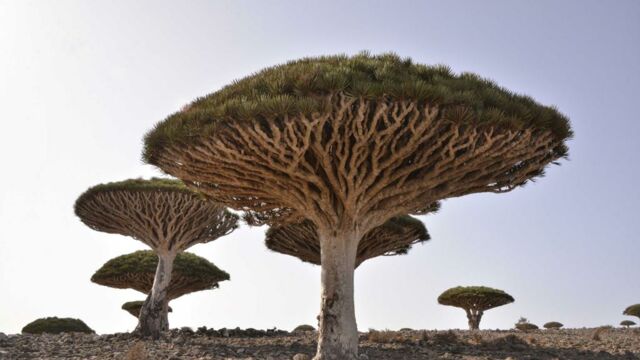Not far from the Gulf of Aden, in the Arabian Sea, lies an extraordinary island. Spread over 3,500 square kilometres, it offers a mosaic of landscapes combining sandy white beaches, desert plains, rugged peaks and mysterious caves.
Discover our latest podcast
This jewel of nature is called Socotra and is the largest island in the archipelago located off the coast of Yemen. It has been a UNESCO World Heritage Site since 2008 and is sometimes referred to as the 'Galapagos of the Indian Ocean.'
According to studies, Socotra has hundreds of species that exist nowhere else, some of which are very unusual. Such is the case for the Socotra dragon tree (Dracaena cinnabari), a tree that looks like a giant upturned parasol. Or a mega mushroom, depending on your point of view.
A leafy crown perfectly adapted to the environment
This plant, which can grow up to 12 metres tall, has evergreen foliage that grows in an unusual way. The leaves emerge only at the tips of the youngest branches and point skywards, forming a green crown that appears to rest in a flat-ish top on the tree's tangled arms.
Although it looks strange, this shape is highly adapted to the arid conditions in which the genera dwells. The crown of leaves captures rain and moisture from the air and redirects it to the branches and trunk, reducing evaporation and providing shade for branches.

Thanks to this, D. cinnabari is able to withstand high temperatures and drought, taking advantage of the scarce water its environment offers. But this is not its only characteristic. Like other dragon trees, this tree is also unique because of its reddish resin, called dragon's blood.
Legendary sap
It is this substance that gives it its name. The name is taken from the myth of Hercules (or rather Heracles) and his twelve labours. According to the legend, one of them consisted in stealing the golden apples from the Garden of the Hesperides, which were guarded by a hundred-headed dragon, Ladon.
To reach the fruit, Hercules killed the beast and its blood spilled on the ground, giving birth to dragon trees. With a little imagination, one can indeed see in the branches of the tree a kind of multi-headed creature and on its trunk, bark like reptile skin.

However, the legend of the dragon tree does not end with the adventures of Hercules. Its resin has been used since ancient times in traditional medicine. It is said to have anti-bacterial and anti-inflammatory properties. It has also been used for a long time as a colouring substance or as a varnish, particularly for violins.















